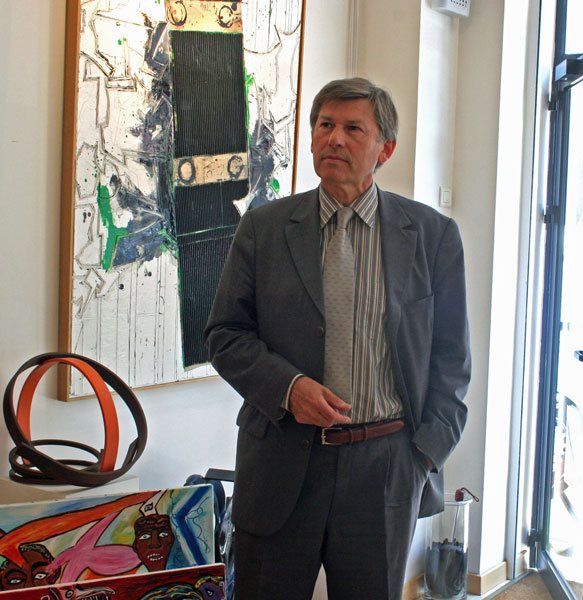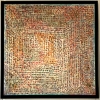Exposition Xooang Choi du 6 mars au 19 avril 2014
Galerie Albert Benamou
Véronique Maxé
24, rue de Penthièvre
75008 Paris
France
Tel: +33(0)1 45 63 12 21
www.galeriebenamou.com/La galerie Albert Benamou - Véronique Maxé présente pour la troisième fois à Paris une exposition de sculptures et de dessins de l’artiste coréen Xooang Choi. Dans une nouvelle série «Blind for the Blind» le jeune homme poursuit l’exploration de ses themes obsessionnels qu’il incarne par des figures hyperréalistes en résine minutieusement ciselées.
L’impossible communication entre les êtres, les pulsions de vie et de mort, la sexualité, la douleur d’exister, la fracture sociale. Une anatomie d’écorchés, de fantômes silencieux qui claudiquent leur humanité blessée en proie à toutes les variations de la solitude.Fleeing to Canada where Mackenzie was born her grandfather Alexander Anfilov, taught her to draw from a young age, shaping the style of her work today. Mackenzie describes her journey as an artist by reflecting upon her desire to fulfill her artistic passions “my experiences, my emotions, my hopes and my challenges often can’t be expressed by words, but are expressed through my work and the striving to be the artist I can be. Ultimately this drive is what has led me back to Paris, where it all began for my family”.
| L’Art Contemporain, la photographie, le cinéma, à travers des parcours singuliers, dissèquent avec une férocité jamais atteinte le Théâtre de la Cruauté. Tyrannies, massacres sériels et répétés, désastres de la guerre, traumatismes psychiques, et leurs exorcismes... |
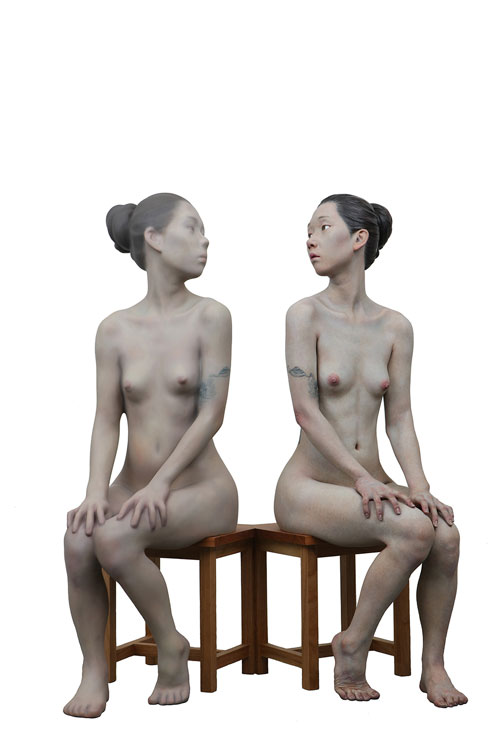 |
|
XOOANG CHOI Reflection 2012, 82w x 52d x 87h cm, Oil on Resin, Solid Wood |
| Le 20 ème siècle a ouvert un champ plus large au langage du corps pour les artistes. Il devient une expression plastique, un spectacle, une prospection sensorielle où se déclinent toutes les souffrances et le refoulé d’une société. A chaque génération se succèdent des guides, des acteurs qui tentent d’illustrer des conflits, entrainent leur propre chair, leur «moi peau» à des facéties plus ou moins morbides. Le Surréalisme et le Dadaïsme tournent le corps en dérision, le parodient, le machinisent, le «nihilisent». Puis il devient l’œuvre, pour le créateur comme pour le spectateur. L’actionnisme viennois à travers des rituels barbares, orgiaques, de sangs et d’excréments va s’employer à dénazifier une nation toute entière. Le Body Art propulse sur la scène des happenings sado masochistes: Marina Abramovic, Gina Pane, Ana Mandieta s’immolent dans des auto flagellations extrêmes qui oscillent entre la meurtrissure physique et l’automutilation. |
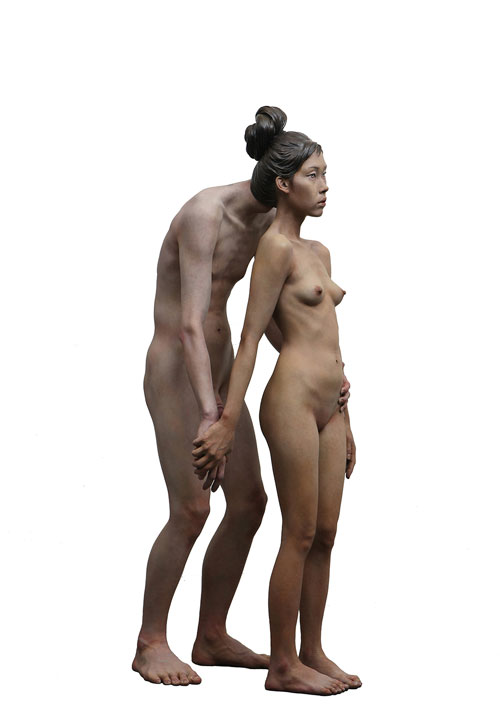 |
|
XOOANG CHOI Perception 2012, 50w x 30d x 86h cm, Oil on Resin Courtesy GALERIE ALBERT BENHAMOU
|
|
Après le sacrifice, l’immolation, une certaine forme de maniérisme et d’ironie s’insinue. L’enveloppe s’échappe, se déforme, et des marionnettistes du bricolage d’identité instaurent un «ordre anatomique nouveau». Matthew Barney met en image une humanité hybride, les Cyborgs, dans son cycle de films Cremaster. Patricia Piccinini accouche des créatures mutantes, les frères Chapman des enfants androgynes hypersexués. Ron Mueck, Evan Penny, Gullivers méga-réalistes fabriquent des géants mélancoliques, Maurizio Cattelan des «mini me», un garçonnet Hitler. Duane Hanson expurge les anti-héros de la société américaine, tandis que Marc Quinn ampute, Louise Bourgeois tronque, Orlan greffe. Le cinéma n’est pas en reste. David Cronenberg (Existenz) ou Pedro Almodovar (Dans ma peau) déclinent les désordres de scientistes qui expérimentent leur folie de démiurges sur des innocentes ou des consentants cobayes. Frankenstein en est le père légitime, monstre douloureux sorti du laboratoire d’un savant hanté. Suivi par les créateurs des films gore qui rivalisent en hémoglobine de prouesses techniques et d’effets très spéciaux. |
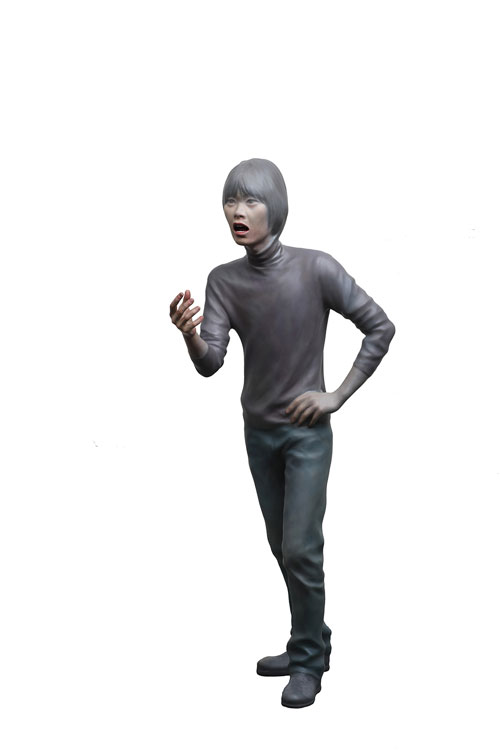 |
| XOOANG CHOI Speaker 2011, 30w x 38d x 84h cm, Oil on Resin Courtesy GALERIE ALBERT BENHAMOU |
| L’originalité de Choi Xooang est de s’intéresser au lien, dans tous les sens, - le couple, ou plutôt son impossible - qui tisse par la couture, la ligature, le nœud, tout ce qui exprime l’attachement mais surtout l’arrachement. Son vocabulaire dissocie ses figures autour du double, mais de doubles contrariés: pas de fusion, pas de séparation, des unions siamoises, zoomorphes, homophiles. Des Jeunes filles désemparées, dupliquées, se cherchent un reflet dans un miroir flou. Etreintes par derrière, pénétration au poing, répression du désir, imbrications, vampirisations mentales (comme chez Edvard Munch). La pulsion morbide solitaire, l’empêchement, se substituent à la douceur et aux grandes espérances. Nul ne se regarde sauf pour se contraindre. Ces corps à corps, contre - corps, deviennent des allégories d’amours contrariés. Les personnages, s’aveuglent, se violentent avec une désespérance aigüe. Les chairs, traitées avec une éblouissante technique, se superposent comme les pelures d’un oignon. Livides, tourmentées, bleuies, obscènes, comme celles de Lucian Freud dont il admire les oeuvres. L’épiderme devient sur-derme, armure fragile corsetant ces fragiles silhouettes. Des rubans suturent les torses, les chevilles, cousus avec la grâce d’un Watteau travaillant les bas et les taffetas, mais la férocité d’un Laclos dans les liaisons dangereuses. Les blessures stylisées sont aussi incurables que celle d’Amfortas dans l’opéra de Wagner ou le grec Philoctète abandonné sur son île. Son humanité est jeune et les premiers balbutiements de ces égarés se font dans la douleur et la convulsion. Les adolescents s’entrechoquent, mains crispées, os contre os, œil pour œil, dent pour dent... se muent en chiens, autruches, et l’animalité transgressive de chacun affleure dans ce combat à tue et à toi. On y retrouve l’influence de Francis Bacon, toujours en fond de ring. |
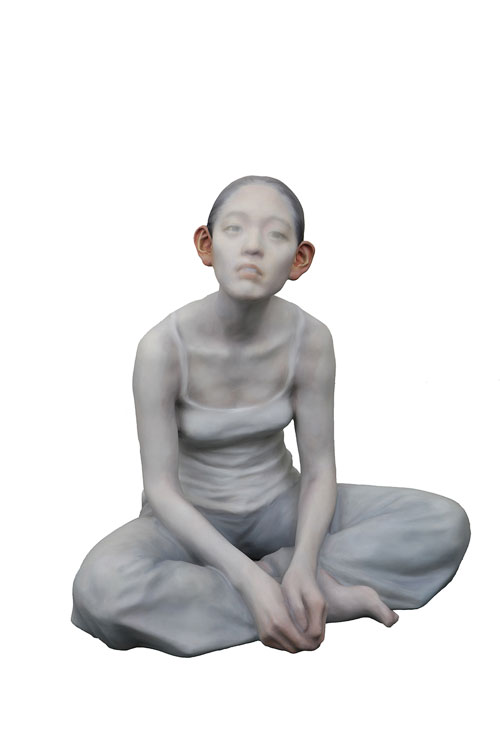 |
| XOOANG CHOI Listener 2011, 58w x 50d x 58h cm, Oil on Resin Courtesy GALERIE ALBERT BENHAMOU |
| Les prothèses monstrueuses, complètent et appareillent sa collection de freaks. «Le corps comme la prothèse du moi» déclare David Le Breton. Comme Cronenberg dans son film «Crash», Choi accentue l’érotisation perverse fondée sur la fascination et la répulsion. Un fétichisme du handicap. Au delà, il raconte aussi en la symbolisant, la part mutilée de chacun. «Le manque rend humain» disait Michel Journiac. Des dessins anatomiques contrebalancent en études délicates l’impact mortifère de ses sculptures. Lavis, aquarelles aux couleurs tendres, érotiques, comme ceux de Rodin ou de Klimt, traits légers de crayons, larmes laiteuses dans des yeux gorgés, sexes mêlés, prothèses-jambes de chaise, crânes habillant les visages comme des masques de carnaval. Auto-sensualité d’un enfant autiste qui se cherche des jouets, des objets transitionnels et des consolations, pour ne pas s’effondrer. La tendresse affleure à travers ce regard mouillé, un œil unique tacheté, planète solitaire. Les grands yeux des enfants dans les mangas coréens (manhwas). Pour cet écorcheur de suppliciés du sentiment, ces «carcasses potentielles», le corps devient un symptôme, une somatisation des conflits psychiques, sociaux, institutionnels. Cet artiste écartelé, dans un pays déjà divisé, incarne le paradigme de l’altérité. Dans ces figures miniatures qui deviennent des doubles d’autoportrait il modifie notre perception des limites de l’humain et établit une identification au blessé, à l’incomplet, au mutilé. Une passerelle de compassion, de réhabilitation du lien social, émotionnel.
|
The Blind for the BlindHan-seung RyuArt Critic & Curator at the National Museum of Contemporary Art, Korea |
| In 2007, Xooang Choi held a solo exhibition titled The Vegetative State. Choi has continuously explored ordinary people and the social milieus in which they live. His interest centers around how social systems – as they become both accelerated and urban centers expand – become more standardized in order to manage and control people more effectively. Most people have no choice but to adapt to these changes, and some – without their knowledge – are brought to a standstill (become helpless), a condition Choi has termed “The Vegetative State”. The sculptures in his embody this “state”, drooping almost lifelessly and appearing resigned, as if they are suppressed by a great force. In 2009, Choi presented two works The Wings (2009) and The Hero (2009), both of which reveal his interest in the issue of “microfascism”. The French philosopher Felix Guattari’s analysis of capitalism and fascism noted that figures of authority in a capitalist society try to control the population by making their values internalized by the masses. That is to say, what the society desires is induced, and the masses in turn follow the desired actions voluntarily. Even though it may appear that those following authority desire something forced upon them by an outside entity, the desires may in fact be their own. The military regime that governed Korea during the 1960-70s emphasized the value of the collective over the worth of a single individual under the guise of growing the industry and economy. The people of this generation followed the direction established by the authority figures and regarded themselves the protagonists and heroes of Korean society’s progress. However, as time passed, this historic era has been (re)assessed, raising the question of whether its generation was in fact heroic or if they had been manipulated by the ruling party. The Heroes and The Wings specifically address these longstanding issues. In the works mentioned above, Xooang Choi began examining the relationship between the collective and the individual, exploring issues of generation, ideology, and history. In later works, Choi focused on observing the relationships between different social groups rather than trying to classify an individual within the collective. Following the insight of French postmodernists like Guattari and Michel Foucault, Choi developed his own insight into how collectives disregards certain characteristics of an individual in an attempt to integrate them a single unified stream. In this context of fascism, whatever does not fit in the mainstream is deemed abnormal. It was this tension that prompted Choi to develop two distinct bodies of work, the Islets of Aspergers (2009) and Speaker (2011) and Listener (2011). |
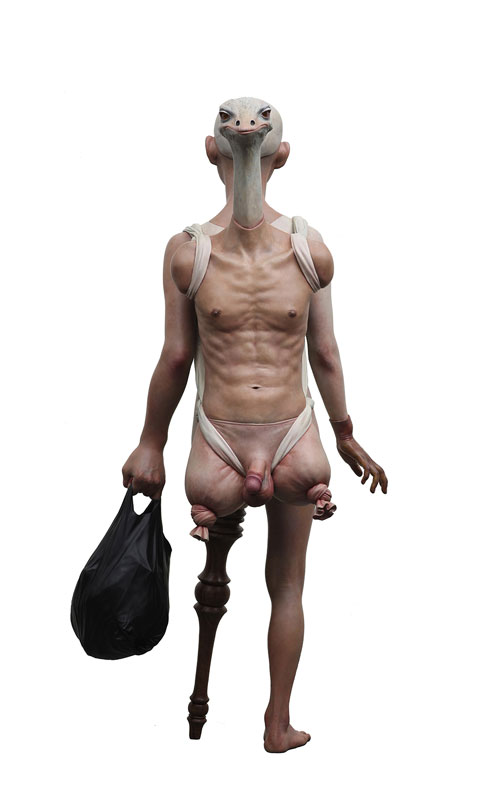 |
| First, Choi took interest in social minorities. In his series Islets of Aspergers, he focused on people who have Asperger’s syndrome. Asperger’s syndrome is characterized by individuals who have difficulty integrating into mainstream society and lack basic social communication despite normal linguistic and cognitive development. Those displaying this syndrome may also be sensitive to sensory stimuli such as sound, light, smell, and taste, and they have a tendency to become intensely focused on idiosyncratic subjects, sometimes displaying an outstanding gift in a specific subject. Given the broad definition of Aspergers, Choi asks the question: is it possible that certain individuals are described as outside the norm and suffering from psychological conditions based solely on their behaving outside the norm? Anybody can become immersed in a certain subject, and there may be a difference in intensity and focus, but this is the kind of distinction which separates certain individuals further from social norms and not the basis for medical condition. Second, Choi has explored the issue of perspective, focusing on the two roles of Speaker and Listener. Exhibited as a pair, his sculptures show a male figure (Speaker) with his hand raised, suggesting that he is saying something, while the female figure (Listener) sits passively and listens to the speaker. The artist has depicted the hand and the mouth of the male figure and the ears of the female figure clearly, while the rest of the body was sculpted to appear blurry. In addition, the figures are clothed, an unusual feature in Choi’s work. At first glance, the Speaker on the higher pedestal seems to dominate the Listener who occupies a lower pedestal. One would assume that the former holds the power. However, this is not the only viable interpretation of the work. While the female Listener sits comfortably wearing loose track pants, the male Speaker stands in a precarious position, wearing a tight pair of jeans. Moreover, most viewers would consider the clearly defined areas of the body more important, but the rest of the body rendered indistinctly reveals that the listener appears more composed and relaxed than the speaker. As such, power can easily shift depending on the point of view — a point that informs Choi’s critique; that social minorities are created from similarly arbitrary viewpoints. Recently, Xooang Choi’s work has begun to explore explicitly “ordinary” subjects. Although themes of society, collective and cultural structures are important, it is always made up of individual “humans”. Choi sculptures frame the importance of these individual traits examining self-awareness and the inner conflicts of ordinary people, focusing in particular on the ways these elements manifest in the subjects’ physical stature. By presenting two bodies at the same time, the artist visualizes the subtle psychology and attitudes of individuals through the dichotomies of the subject and object, active and passive, dominant and submissive, exposed and hidden, variable and constant. |
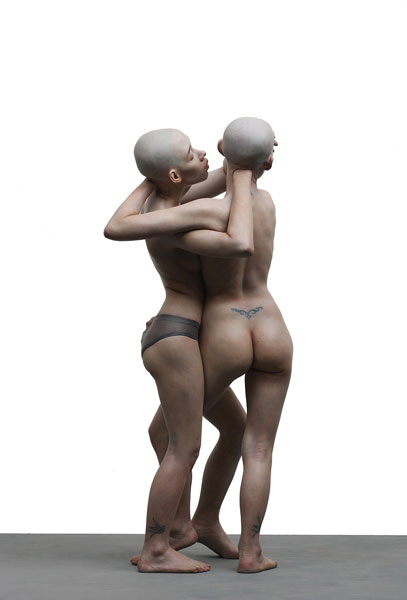 |
| Comprised of two female figures, the work Reflection (2012) addresses “self-awareness”. The work presents a woman looking in the mirror and the shape of her body reflected in the mirror. One figure is rendered clearly but the other remains indistinct. It is easy to look at the pair and say that the clearly defined form is the actual model and the blurry form is the mirrored image, yet the opposite is true. The viewer can recognize this by looking at the tattoos on her arm, ankle, and waist. The model may have seen a reversed image of herself in the mirror many times, but she has probably has never seen herself reversed three-dimensionally. A mirror shows our reflection as an exact copy but nevertheless still a reversed image, different from our actual appearance. In this same way, humans have difficulty perceiving their bodies and personalities accurately. Humans are more likely to be familiar with looking at themselves through another’s gaze rather than their own. The model in Reflection has gently turned her head to look at herself and one can see that her expression shows cautiousness, curiosity, and surprise. In another work, Isometric_Male (2013) is also formed of two figures. They are in fact the same person. The same applies for Isometric_Female (2013). The two male figures depicted in Isometric_Male put their hand atop each other’s head. The naked man covers the mouth of the other, while his male counterpart who is wearing panties covers the genitalia of his companion. In a similar manner, the two women depicted in Isometric_Female place their hands on one another’s heads. The woman wearing panties covers the eyes of her mirror image while she in turn places her hand inside her companion’s panties. The sculptures reveal a scene reminiscent of a puppet show because their hands are placed into the head of the other almost as if they were directing them. But because both figures are doing the same thing, it is difficult to discern which one is human and which is the marionette. One man wants to say something but he is unable to do so because his mouth is covered. The other man wants to expose himself but his sex is covered by his opposite’s hand. To say something and to cover one’s mouth, to reveal and to be covered up at the same time, this reveals the inherent inner conflict of the individual. Settlement (2012) and Colonization (2013) reflect on the “changeability of the body”. Though historically the human body was believed to be fixed, inviolably determined at birth, recent development in medicine and plastic surgery has made it possible to change a part of the body or even get an organ transplant from another. These changes have affected both the attitudes and awareness of humans as well as the definition of what being human is. Many people now consider a body to be infinitely changeable. In the future, a human body may be combined with artificial organs, machines, and even artificial intelligence. And when this happens, the definition of the body, subject, and awareness will also be completely transformed. Settlement is a sculpture made up of a combination of completely disparate anatomical parts from humans, animals and objects. In particular, the face is awkward; if one assumes that the human is wearing a mask skull, then it would not be possible for the teeth of the skull to appear more in-set than the lower lip. Or if one supposes that the skull is the subject, then it would appear that the skin had been transplanted onto the skull. Together this highly refined and surreal hybrid human makes it difficult to determine whether it is a living being or if the skull is the subject. The rear view of Colonization is also unsettling due to the corset-like strings tied to the back of the sculpture. It looks like an item of clothing but it is indisputably joined at the stomach. Moreover, the figure is wearing shoes, but the tips of the shoes are actually toes. Again, it is difficult to distinguish which part is a human body and which part is an object. It is also difficult to separate the subject and the object. |
Xooang Choi et les absents à eux-mêmes et au monde
|
|
Rien ne définit mieux le travail de Xooang Choi que la forme réfléchie d’un verbe, forme encore en usage au XVIIème siècle : « S’apparaître ». Comme si ce qui soudain surgit émergeait en dehors de l’artiste lui-même. Mais en même temps cette forme réfléchie tend à signifier : apparaître en soi-même. Dans les sculptures du Coréen les deux dimensions ne sont plus qu’une. Et le sens de l’être devient paradoxalement religieux. Reste à se demander qu’est ce qu’un tel art ouvre ? Que devient le verbe « sculpter» dans ces corps dont la nudité oblige à un autre regard sur l’existence ? La sculpture de Xooang Choi est une expression d’un projet du monde : projet non forcément rêvé mais produit d’une énergie spirituelle. D’où la motricité l’œuvre. Elle permet de garder vivante la marque non seulement du sentir mais de l’ouverture à une lumière étrange dans travail du désétablissement puisque les corps de résine perdent pied, renvoient du connu à l’inconnu. Ils rendent démuni en devenant l’avènement d’une douteuse trans-passabilité. Xooang Choi invente la spiritualisation du sensible par sa figuration qui sort d’un simple réalisme. Elle émane par l’appréhension d’un fond primordial pour laisser naître une altérité rayonnante et terrible car impossible. La verticalité intègre des résistances, des déviations. Tout s’expose, entre en incidence réciproque. Chaque corps devient mobile dans sa fixité. Il gravit sa chute. Et c’est là toute la poésie de l’œuvre. Poésie de la réalité. De sa pesanteur et de sa surrection. Les deux s’entretiennent l’une l’autre dans un change perpétuel. Il y a le large et l’étroit, le clair et l’obscur. La présence du souffle. Des questions se posent. Celle-ci par exemple : les errants de Xooang Choi peuvent-ils se supporter ? Rencontrer l’autre ne revient-il pas à ce que disait Du Bouchet : « on n’y entrera pas sans être disparu » ? L’œuvre permet d’éclairer une expérience présente dans laquelle nous sommes induits, « contemporains » de la destruction et de la misère humaine. Elle manifeste le plus profond de l’art. Demeurent des gouffres rendus visibles entre la nécessité du secret et l'impératif de la l’image. L'abandon, l’absence, le clair, l’obscur : tout devient aussi immobile qu’affolé. Tout ce que les êtres anonymes de Xooang Choi ont pu savoir l’artiste l’aura montré. Jean-Paul Gavard-Perret |
BIOGRAPHIE |
|
Born in 1975 in Seoul, South Korea/ Lives and works in Seoul 2005 2002 |
Solo Exhibitions |
|
2013 2010 2009 2008 2009 2010 |
Group Exhibitions & Art Fairs |
|
2008 2007 2006 2005 2004 2003 |
ACTUALITES |
| 2014 Solo Show, “The Blind for the Blind”, Galerie Albert Benamou |



